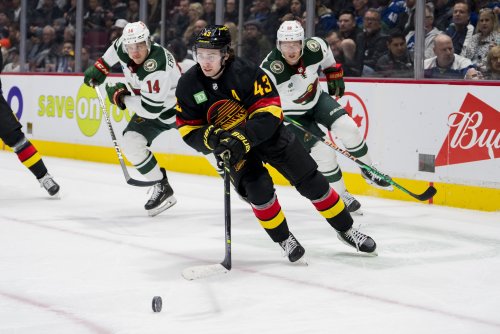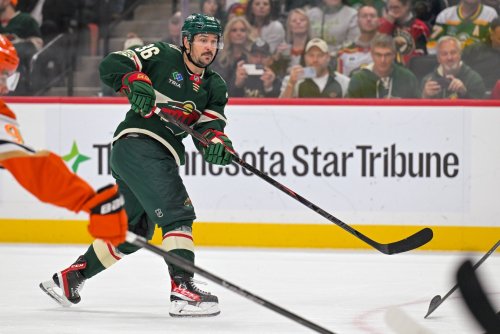
For those who have followed the Minnesota Wild closely this season, it’s become a bit of a consensus among fans that the Wild match up best against the Vegas Golden Knights for the first round of the playoffs. In the past six games between the teams, the Wild are 4-2-0, although one of those wins came in the shootout. Based on that record, one would hope for a fairly even matchup between the two teams in a playoff matchup. In the upcoming two-game series, we’ll see if that’s really true, or if the past six games Minnesota has played against Vegas have involved some luck.
Vegas is a scary team that’s been heating up of late. They’re rated the sixth-best team in MoneyPuck.com’s Power Rankings, and they don’t really have a weakness in any area — they’re just good by possession metrics, team shooting percentage, and team save percentage. They do this in much the same way that the Wild do in terms of team play-style: they possess the puck, patiently regroup, and wait for high-value opportunities. On defense, they allow lots of shots but limit opponents to low-quality chances on the outside.
This hot play has led to Vegas claiming the top spot in the West Division, and so these two games will have a large bearing on whether the Wild play Vegas at all. Vegas is slightly favored by prediction models on MoneyPuck and by sports betting lines, between 52% and 55% to win the game. MoneyPuck predicts that there is a 64.5% chance that Vegas will win the division, but that prediction is highly leveraged against these games against the Wild - if Vegas loses tonight’s game in regulation, these chances drop to 50/50. The reason for this is that while Vegas holds a four-point lead in the standings over Colorado, Colorado has played one less game. Since both teams are more likely to win than their opponent on any given night, a two-point lead vs. a game in-hand is nearly a dead heat.
Furthermore, the remaining schedule heavily favors Colorado in the quest for the Honda West Division title. Looking at the tweet below, Colorado gets to beat up on the division’s bottom feeders and has a “prove-it” four-point game against Vegas - this game alone has Colorado two points from controlling its own destiny. On the other hand, Vegas plays five of six games against playoff teams including the hungry St. Louis Blues, who are still fighting to make the playoffs and gave the Wild a lot of trouble over our past three games. Minnesota plays a similar style as Vegas, so Vegas could run into the same trouble as we did against St. Louis.
Perhaps most importantly, Colorado currently holds a 2-game lead in the “RW” tie-breaker. These are regulation wins, meaning wins that came without the interference of 3-on-3 OT or the shootout, which are most relevant because Playoff Overtime is played at 5-on-5. These factors all give Colorado a puncher’s chance to overtake Vegas for the division, but it rests heavily on a Wild win.
So, who are the Vegas Golden Knights? Their team identity is one that burst onto the scene as soon as they came into the league as an expansion team. They have a reputation for possessing the puck with smooth-skating defensemen who distribute the puck effectively, stifling opposing offenses. This is confirmed by analyzing two statistics: Corsi and Expected Goals.
Corsi measures the number of shot attempts — a very simple statistic. Teams which shoot a lot have a high Corsi, and the only difference between this and shots-on-goal is that Corsi counts a shot attempt while shots on goal only count if the shot makes it on net. Expected goals are much more complicated, using algorithms to weight these shot attempts more heavily based primarily on shot location and the speed of play. Essentially, this rewards high-value scoring chances while shots-on-goal or Corsi do not. Vegas dominates opposing teams in both metrics.
However, their reputation for only taking high-value shots has been less true this year, as they have a similar xG rate (53.3%) to their Corsi rate (53.2%). This means that at 5-on-5 play, they produce 53% of the shots, and the value of these shots is about even because the two numbers are equal. Compare this to the Wild - xG rate 51% and Corsi rate of 45% - and there’s a clear difference. The Wild take less than half of the shot attempts while on the ice, but still control the quality of scoring chances with an xG rate above 50%; therefore, they must be seeking only high-quality chances.
The engine of Vegas’s team has three pistons: their defense, goaltending, and their top line. The pairings and line combos of Hague-Whitecloud, Martinez-Theodore, Marchessault-Karlsson-Smith, and Pacioretty-Stephenson-Stone have all played over forty games while dominating 5-on-5 play. The MO of these groupings is mostly “fun, but good” in that they rely on creating offense to dominate play. Good luck stopping Mark Stone’s line especially, as he looks like a magician at times in his ability to stickhandle around opponents and pass the puck to create scoring opportunities. On the other hand, Hague-Whitecloud seem to be more of a shutdown pair who still dominate, but do so by slowing the game down and allowing very little on defense.
This year, Vegas has played more of a run-and-gun style than usual. This can be beneficial to a team with an edge in statistical measures of scoring rate, because it gives both teams more chances to regress to these predictive statistics. Track meet hockey essentially creates a larger sample size, which lends itself better to analysis via the Law of Large Numbers. The downside to this is it can be hard on your goalie, but this year the tandem of Robin Lehner and Marc-Andre “The Flower” Fleury have been nothing short of elite.
Vegas has given it’s goalies the 11th-hardest workload measured by xG, and the 3rd-hardest in terms of high-danger shots. However, the goalies have taken this in stride and saved the team about 12 goals above expectation. Both goalies are posting save percentages above expectation based on shot danger against, and no doubt part of this is that they can roll out either goalie with confidence helps reduce fatigue in the face of this workload.
Burning Questions
Do the Wild really want Vegas as their first-round playoff opponent?
This two-game series has the power to take Vegas out of the driver’s seat for the division. Minnesota has a 99% chance of playing the lower seed between Vegas and Colorado, and winning these two games would go a long way toward making Vegas our matchup.
That scenario would bring the season series to 6-2 favoring the Wild, and in that case it’s hard to say you don’t like the outlook. The other option is that Vegas steamrolls us and continues their hot play, giving them a solid chance of claiming the division over Colorado. In that case, playing Colorado would be better because you never want to run into a hot team with hot goaltending in the playoffs. Overall, it feels like this series won’t have Minnesota fans in despair as it affects their playoff opponent. The best thing to see would be 2-0 though, as it definitely implies a good chance to win in the first round vs. Vegas.
How should the Wild match Vegas’s top lines at home?
Expect much the same lineup for the Wild coming off of a win vs. St. Louis. The first thing you’ve got to stop is Mark Stone’s line with Pacioretty and Stephenson. It contains Vegas’s most dangerous player in Mark Stone (a bona-fide Wild killer this year) and is significantly better defensively than the second line. Because of their defensive abilities, it’s probably best to put Greenway-Eriksson Ek-Foligno up against them. Attacking this line head-on with scorers is playing right into Vegas’s hands, and Minnesota’s scoring lines are bad at retrieving pucks on our defensive boards. Since those lines would be shredded by Stone’s line, it’s best to call it a push and hope the GREEF squad can hem Stone into his own end at least as often as he does to us.
Against the second line, however, there are more scoring chances to be had. It will be interesting to see whether Evason wants to counterattack this line, or match up Sturm’s line with them to shut it down. On the one hand, shutting these lines down goes a long ways against Vegas, who have a relatively weak bottom-six forward group. Sturm also provides counterattacking upside, and Parise has oddly seemed faster after being out with COVID, so these two with Bonino could be a good recipe. This would allow Fiala and Kaprizov-Zuccarello to pick apart easier matchups down Vegas’s lineup.
On the other hand, some teams need to be pressed back on their heels in a Herb Brooks-style “You don’t defend them. You attack them.” Vegas has a checking third line in Glass-Roy-Tuch which has been stingy, and getting our scorers away from this group would be good for our offense. Overall, I think it’s wise to try and exploit Vegas’s run-and-gun style with our own big guns after shutting down Stone’s line, because for once we actually have the players to do it. I’d rather let Tuch’s line “shut down” Parise-Sturm-Bonino than our elite scorers.
Did St. Louis wake up the Wild?
It’s true that the Wild didn’t have much to play for against St. Louis over the weekend. They gave quotes that indicated they were upset at losing the first game and played to the buzzer in the next two games, but if we look complacent after a big OT victory Saturday I’ll have my doubts about Minnesota’s regular season fire. I don’t want to see the team fall asleep at the wheel just yet, and in a chance to test their playoff opponent they had better show some intensity and learn everything they can.
Think you could write a story like this? Hockey Wilderness wants you to develop your voice, find an audience, and we'll pay you to do it. Just fill out this form.









Recommended Comments
There are no comments to display.
Join the conversation
You can post now and register later. If you have an account, sign in now to post with your account.
Note: Your post will require moderator approval before it will be visible.